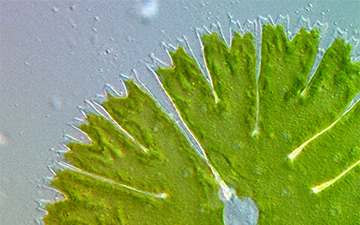Micrasterias is a unicellular green alga of the Desmidiales order.
Micrasterias, commonly known as green alga, is a eukaryotic, unicellular organism, and species vary in size reaching up to hundreds of microns. Micrasterias displays a bilateral symmetry, with two mirror image semi-cells joined by a narrow isthmus containing the nucleus of the organism. This dual semi-cell structure is unique to the group of green algae to which Micrasterias belongs. Each semi-cell contains a single large chloroplast, the site of photosynthesis for the Micrasterias. Chloroplasts within Micrasterias contain chlorophylls A and B and the enzymes required for photosynthesis. The sugar created is used to provide energy for the organism or, if not used, taken up by many small round pyrenoids which are embedded in the chloroplast. They convert the sugar to a starch for storage.
Micrasterias can produce both asexually and sexually. Asexual reproduction occurs via mitosis. When this occurs the genetic material of Micrasterias is duplicated and two small semi-cells grow between the original semi-cells, gradually increasing in size. Sexual reproduction occurs through a process called conjugation whereby two organisms come together and fuse their haploid cells to form a diploid zygote. This zygote typically forms a thick protective wall which can allow the organism to remain dormant for many months to survive cold winters and long droughts. When adequate conditions resume, the zygospore will germinate, undergo meiosis, and produce new haploid algal cells.
(From: Wikipedia, July 2015)




